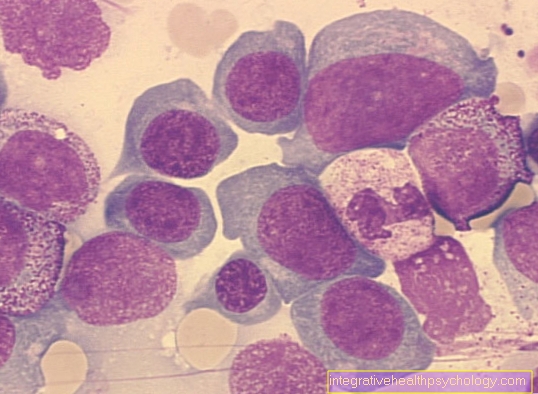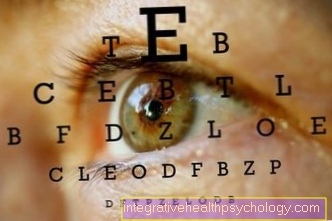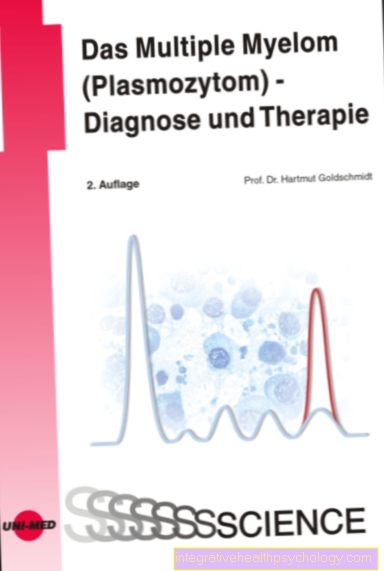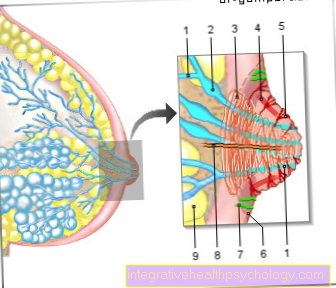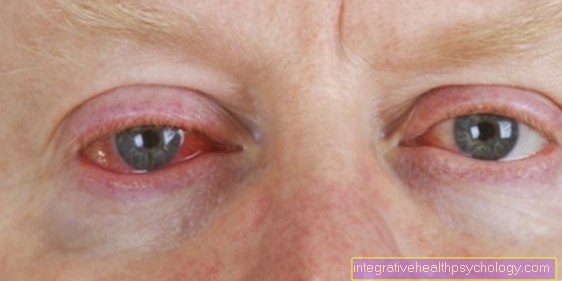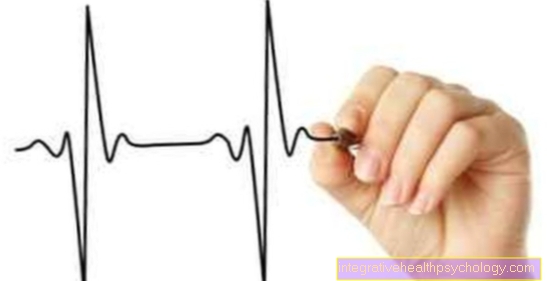The symptoms of liver cancer
introduction
Liver cell carcinoma (liver cancer) is a serious disease of the cells and tissue of the liver. The cause of this uncontrolled cell proliferation is in most cases due to various previous diseases of the liver.
80% of hepatocellular carcinomas are based on cirrhosis of the liver, the cause of which lies in excessive alcohol consumption or an inflammation of the liver (hepatitis). The metabolic disease hemochromatosis can also lead to liver cell carcinoma.

Overview of the typical symptoms
-
Pain in the upper right abdomen
-
Tiredness / exhaustion
-
itching
-
Jaundice - yellowing of the skin and eyes
-
fever
-
Weight loss
-
diarrhea
-
Ascitis - water in the abdomen
-
confusion
The pain
Pain is not a typical symptom, especially in the early stages of liver cancer. On the contrary, liver cancer grows unnoticed for a long time because it causes almost no pain and hardly any other symptoms. This is one reason why liver cancer is such a serious disease. By the time the liver cancer becomes conspicuous and causes pain and other symptoms, it is usually very advanced and often spread.
If there is pain as a result of liver cancer, this is usually expressed in the right upper abdomen, often at the beginning only as an uncomfortable feeling of pressure or dull pain. This pain is most often caused by the cancer increasing the size of the liver, which causes tension in the capsule that surrounds the liver. Because the liver itself is not sensitive to pain, only the capsule surrounding it.
Read more about the topic here: Liver pain.
Right costal arch pain
One of the few symptoms that liver cancer almost always causes is the pain under the right costal arch. Often this manifests itself at the beginning only as a slight dull pain or even just as a feeling of pressure.
Unfortunately, if the pain in the right upper abdomen is caused by liver cancer, the underlying disease process is usually very advanced, as the liver itself is not sensitive to pain. Only the surrounding liver capsule reacts to the increase in size of the organ with tension and then painfully.
Tiredness
Fatigue and exhaustion are one of the important early symptoms of liver cancer. However, these are also very unspecific symptoms that can occur in the context of many other diseases or are simply based on stress.
In the course of a severe liver disease and thus also with liver cancer, tiredness and exhaustion increase enormously and can lead to a loss of consciousness and even a coma.
The itching
The majority of patients with liver diseases such as liver dysfunction or liver cancer complain of severe itching all over the body.
The exact pathophysiological mechanism for this has not yet been clearly clarified. It is currently assumed that the decreased liver performance leads to impaired excretion of bile acid. This remaining bile acid leads to irritation at nerve endings of the skin and thus leads to the described itching.
The yellowing of skin
Jaundice is the yellowing of the skin and eyes. This discoloration is based on a lack of elimination of the so-called bilirubin from our body. Bilirubin is formed in our body via various metabolic cycles and has to be excreted via the liver and, in small parts, also via the kidneys.
To make this possible, the bilirubin has to be converted in the liver into a form in which it can be excreted by the body. Most of the bilirubin is then released into the stool via the biliary tract and a small part is released into the urine via the kidney.
If there is a disturbance somewhere in this metabolic chain, the bilirubin remains in the body and is deposited in other organs. Especially in the skin and eyes, which leads to the noticeable yellow color.
In liver cancer, the circulation described above can be disturbed in various places. On the one hand, the cancer in the liver can cause the liver to malfunction, so that the liver can no longer sufficiently convert the bilirubin into the excretable form and it remains in the body. Another possibility is that the liver can still sufficiently metabolize the bilirubin, but the pathways to excretion are blocked.
Bilirubin is released from the liver into the bile ducts and excreted in the intestine. Due to the direct proximity of the liver to the bile ducts, the liver cancer can compress the bile ducts and lead to bile congestion resulting in jaundice.
You can find more information on this topic at: The jaundice.
The water in your stomach
What is colloquially called water in the stomach is also called ascitis or ascites in specialist circles. This is an increased accumulation of fluid between the organs in the abdomen. The cause of this accumulation of mostly water in the abdomen is in most cases a disease of the liver. Severe heart failure or various forms of cancer can also lead to ascites.
In most cases, the water remains unnoticed for a relatively long time at the beginning, since a slow increase in the amount of fluid does not cause pain. Those affected often only notice a slight feeling of pressure in the abdomen or an increase in the circumference of the abdomen or body weight.
If there is a suspicion of water in the abdomen, this can be proven with a simple imaging procedure. The method of choice here is sonography - ultrasound. Ultrasound can be used to very safely and non-invasively detect water in the abdomen.
If the origin of the ascites is unclear or if there are further complications, an ascites puncture may be necessary. This involves piercing the abdomen with a thin needle under ultrasound control and taking a certain amount of ascites and sending it to the laboratory for further examination.
The remaining water can also be drained through this puncture, thus relieving the abdominal cavity. If an examination of the ascites is not necessary, smaller amounts of ascites can also be treated purely with medication.
For more information, read on: Water in the stomach.
The B symptoms
B symptoms denote a triad of symptoms that are typical for cancers of the hematopoietic system. But the so-called B symptoms can also be found in some other forms of cancer, although this is not quite as important a factor as in blood or lymph node cancer.
The symptom triad of the B symptoms includes firstly fever of up to 40 ° C, secondly night sweats - a distinction must be made between normal night sweats and real night sweats, and the person affected may even have to change all of his sleeping clothes several times during the night because they are completely wet , one speaks of night shit - and thirdly, a weight loss of at least 10% of the original body weight within 6 months.
Find out more about this topic here: B symptoms.
The elevated temperature
As with any cancer, liver cancer can experience elevated temperatures in response to a malignant process in the body. However, this is not a specific symptom and can often also be a sign of an infection in the body, which has arisen either as a result of the cancer or independently.
Neurological symptoms
Liver cancer can also lead to neurological symptoms.The lack of metabolic function of the liver is the decisive basis for the development of the symptoms. Depending on the progression of the functional loss of the liver, the so-called liver cirrhosis, different neurological symptoms occur.
At the beginning, the disease manifests itself only through drowsiness, poor concentration, mood swings and speech disorders. With increasing loss of liver function, these symptoms slowly worsen and lead to severe confusion, loss of consciousness, movement disorders and even comatose opacity. The neurological symptoms are particularly pronounced if the person concerned has regularly drunk large amounts of alcohol before developing liver cancer, which has already disrupted his liver and its metabolic function.
The confusion
In the context of liver cancer, confusion can arise. However, this is a late-stage symptom and does not occur in every patient. The cause of the confusion is not primarily the cancer in the liver, but the liver function destroyed by the cancer.
In addition to many other metabolic processes, detoxification of the body is one of the most important functions of the liver. Liver cancer damages the liver so much that it can no longer perform this function and substances that are toxic to the brain accumulate in the body. Above all, ammonia is one of the most important metabolic products in this regard, as it is highly neurotoxic and therefore has to be excreted by the liver to almost 100%. If ammonia remains in high doses in the body for a long time, it leads to severe damage to the brain, which at the beginning manifests itself in confusion and even to a coma.
For more information, see: End-stage liver cancer.
The thrombosis
With all cancers there is an increased risk of thrombosis. Thromboses are small blood clots that block the bloodstream and lead to severe circulatory disorders and, in the worst case, trigger a life-threatening pulmonary embolism after being dragged on.
With liver cancer, the risk of developing a thrombosis is even greater than with other forms of cancer, as the additional factor that comes into play here is that the liver produces the blood clotting factors under normal conditions. If the liver function fails due to cancer, the coagulation factors can no longer be sufficiently formed in the liver. This leads to an imbalance in factors that inhibit and promote bleeding and thus to both an increased tendency to bleed and an increased tendency to blood clots and thrombosis.
You can read more about this topic here: Thrombosis.
Diarrhea
Diarrhea is a very unspecific symptom and occurs in countless diseases. For liver cancer, diarrhea is not a classic symptom that would be indicative. Of course, stool irregularities can occur in the context of liver cancer, but the color of the stool in particular - if the stool is white / discolored - plays a more important role.
Note
All information given here is only of a general nature, tumor therapy always belongs in the hands of an experienced oncologist (tumor specialist)!





